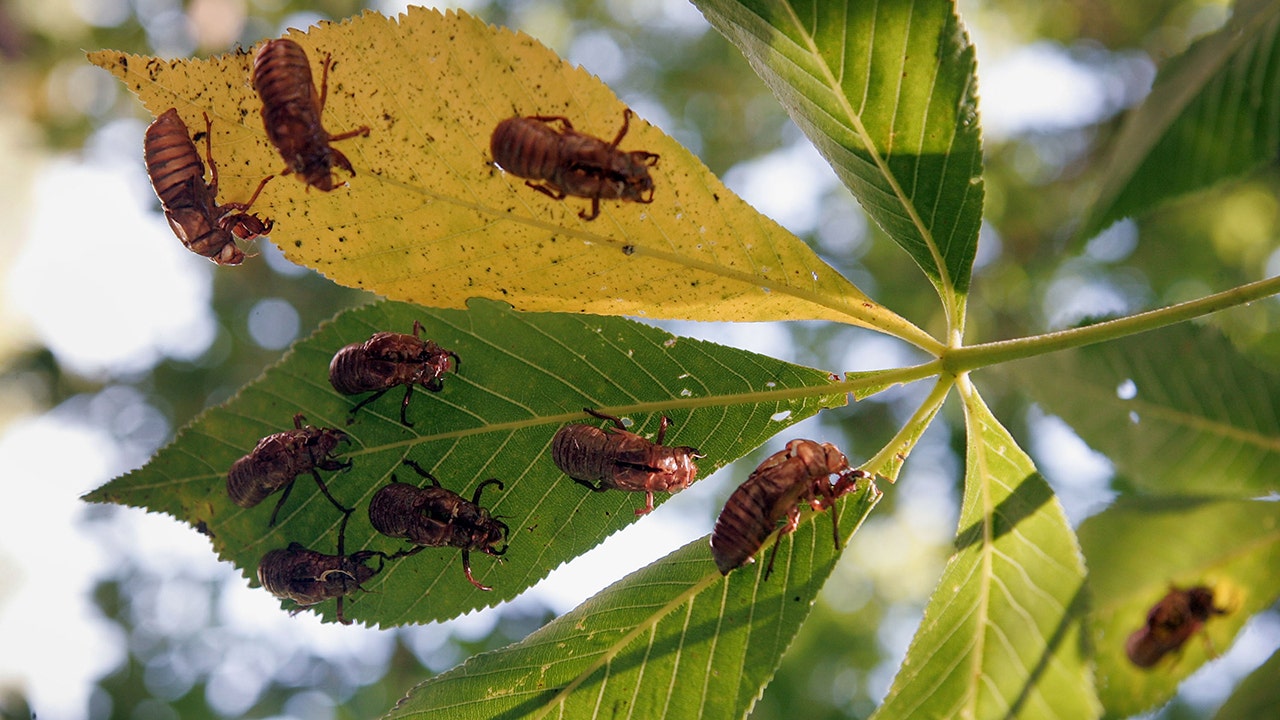Billions of cicadas are expected to start swarming in more than a dozen states in the coming weeks, and while the strange occurrence may be a nuisance for many, scientists say the activities of the noisy flying insects are a natural marvel beholden to northern America — and anglers say the bugs create ideal fishing conditions to net some hefty catches.
After years of living underground as nymphs feeding off the sap of tree roots, the 1- to 2-inch-long bugs will soon emerge from the soil, grow wings and start a frantic mating frenzy lasting several weeks before they will all eventually die near trees. While cicadas are not harmful to humans, they can damage young trees and their dead bodies can pile up and smell.
There are around 190 species of cicadas all over the world, but only in the eastern United States can you find the periodical cicadas, which emerge every 13 or 17 years.
This year will be the first time in 221 years that two types of cicadas — brood XIX and XIII — have risen from the ground at the same time, back when Thomas Jefferson was president, and it is not expected to happen again until 2244.
RARE BROODS OF CICADAS TO ARRIVE SOON: WHEN TO EXPECT THEM AND WHAT IT MEANS FOR YOU

This year will be the first time in 221 years that two types of cicadas — brood XIX and XIII– have risen from the ground at the same time, back when Thomas Jefferson was president, and it is not expected to happen again until 2244. (VCG Wilson/Corbis via Getty Images, Associated Press)
The two broods together span parts of 17 states, including Alabama, Arkansas, Georgia, Iowa, Indiana, Illinois, Kentucky, Louisiana, Maryland, Missouri, Mississippi, North Carolina, Oklahoma, South Carolina, Tennessee, Virginia and Wisconsin, according to the United States Forest Service.
“It is a pretty amazing phenomenon, I mean, it’s unique,” Eric Benson, a professor emeritus and extension entomologist at Clemson University in South Carolina, told Fox News Digital.
“They’re one of the longest-lived insects that we know and the fact that a bug can be underground for 13 years or 17 years, and then almost at the exact same time, they all come out of the ground synchronized,” Benson said. “It’s amazing to me. It’s one of nature’s cooler phenomena in the world.”
The cicadas that have been under the ground for either 13 or 17 years will emerge out of the ground in their final immature state, Benson added.
“They’ll crawl up on a surface, usually the trunk of a tree, or it could be on the side of your house, a car, a fence or whatever. They’re insects, so they have to shed their skin to get to the next stage, and they will go through their final molt where they pull out of their immature skin, and they will be in their adult skin, which will have wings,” Benson explained. “And it takes them like a day or so to do that, it’s not instantaneous. So they’ll molt, expand their wings, harden up and when they’re ready they’ll fly up into the trees.”
Within a day or two, things will get interesting.
“The males will sing and make noise” at that point, Benson said – a behavior called “coursing.”
“They get together in large numbers because it’s more attractive to the females, they sing in the trees and then the females come over, and it’s a giant orgy, a giant mating party,” he explained.
The cicadas mate and then when the female has fertilized her eggs, she takes what is called an “ovipositor,” which looks like a syringe, and she will stick that into the tips of tree branches to deposit her eggs, Benson continued.
Female cicadas make slits in small tree branches and usually lay 20 to 30 eggs in each slit. A female can lay 400 to 600 eggs in a lifetime.

Empty, nymphal skin of cicadas remain in a tree following the hatch of Brood XIII on June 11, 2007 in Willow Springs, Illinois. (Scott Olson/Getty Images)
CICADA INVASION 2024: ARE THESE INSECTS COMING FOR YOUR PLANTS THIS SPRING?
The mating males and females will eventually die after mating and fall to the ground – causing a nuisance for some and food for others.
However, the fascinating process does not end there. A few weeks after the eggs are deposited, they will then hatch.
“And all these tiny baby cicadas that are so small people rarely see them, will either crawl down or fall down to the ground,” Benson said. “They’ll burrow into the ground, latch onto a tree root very close to where their parents had been and then for this, for the next 13 years or 17 years, they’ll feed on the fluids of that tree until everything repeats.”
Homeowners, however, will be left hoping that the dead carcasses do not land in their gardens as they can smell badly if they die in large numbers together. Their loud sounds while mating can also be disturbing. Similarly, young trees may feel the pinch — females lay their eggs in small tree branches which can harm young trees, the Environmental Protection Agency (EPA) says. The agency advises covering maturing saplings in mesh or netting to keep the insects out.

An active periodical map showing where cicadas emerge. (USDA Forest)
For those who see cicadas as an inconvenience, there are ways to protect trees and shrubs.
Kevin Hathorne, the technical director of Terminix Service, a pest control company in South Carolina, advises people to put tight netting over small valuable trees or shrubs when the female cicadas are laying their eggs, so they cannot crawl through.
He says homeowners should cover pools, patio furniture or similar items from cicada or their droppings when they are active. Hathorne adds there is no solid research showing that repellents would be effective in keeping the cicadas away.
Cicadas, however, can also help to aerate lawns and improve water filtration into the ground while they add nutrients to the soil as they decompose.
“A savvy gardener will shovel them up and bury them in the ground and use them as fertilizer for their garden,” Benson said, noting other benefits such as being food for fish and mammals.
“The fly fishermen are very excited because there’ll be so many cicadas in the natural areas of the mountains and around rivers and lakes that the fish will go crazy,” Benson explained. “So anything that eats a bug, a fish, a lizard, a bird, a skunk, a possum will eat cicadas.”

A periodical cicada nymph extends a limb in Macon, Georgia, on March 27, after being found while digging holes for rosebushes. (AP Photo/Carolyn Kaster)
CLICK HERE TO GET THE FOX NEWS APP
Cicadas are not harmful to humans, pets, household gardens or crops, the EPA says. They are also a valuable food source for birds and mammals.
“Even back in history, Native Americans ate cicadas because all of a sudden you’re provided with all this amazing protein falling in your lap,” he added.
The busiest period of activity for cicadas is from the middle of April through early June, Benson explained, and they usually appear after a nice soaking of rain when the temperature of the ground hits 64 degrees. Keep an eye out for these rare broods!







